Staging Colon and Rectal Cancers
The results of the tests used to diagnose and stage colorectal cancer will be used to establish the extent of the cancer. This is called the stage of cancer.
The staging system used for colorectal cancer is the TNM system created by the American Joint Committee on Cancer (AJCC).
TNM stands for:
- T: the size of the tumor and any spread of cancer into nearby tissue
- N: the spread of cancer to nearby lymph nodes
- M: metastasis (spread of cancer to other parts of the body)
Your pathology report will list stages by Roman numerals 0 through IV. As a general rule, the lower the number, the less the cancer has spread. Stage IV is considered advanced, having spread (metastasized) to another part of the body.
The specific details on the TNM staging for colorectal cancer are as follows:
Tumor (T)
T plus a letter or number (0 to 4) is used to describe how deeply the primary tumor has grown into the bowel lining.
TX: The primary tumor cannot be evaluated.
T0 (T zero): There is no evidence of cancer in the colon or rectum.
Tis: Refers to carcinoma in situ (also called cancer in situ). Cancer cells are found only in the epithelium or lamina propria, which are the top layers lining the inside of the colon or rectum.
T1: The tumor has grown into the submucosa, which is the layer of tissue underneath the mucosa or lining of the colon.
T2: The tumor has grown into the muscularis propria, a deeper, thick layer of muscle that contracts to force along the contents of the intestines.
T3: The tumor has grown through the muscularis propria and into the subserosa, which is a thin layer of connective tissue beneath the outer layer of some parts of the large intestine, or it has grown into tissues surrounding the colon or rectum.
T4a: The tumor has grown into the surface of the visceral peritoneum, which means it has grown through all layers of the colon.
T4b: The tumor has grown into or has attached to other organs or structures.
Node (N)
N followed by a letter or number (0 to 2) indicates whether the cancer has spread to lymph nodes near the colon and rectum (called regional lymph nodes).
NX: The regional lymph nodes cannot be evaluated.
N0 (N zero): There is no spread to regional lymph nodes.
N1a: There are tumor cells found in 1 regional lymph node.
N1b: There are tumor cells found in 2 or 3 regional lymph nodes.
N1c: There are nodules made up of tumor cells found in the structures near the colon that do not appear to be lymph nodes.
N2a: There are tumor cells found in 4 to 6 regional lymph nodes.
N2b: There are tumor cells found in 7 or more regional lymph nodes.
Metastasis (M)
M followed by a letter or number (0 to 1), describes cancer that has spread to other parts of the body, such as the liver or lungs. This is called distant metastasis.
M0 (M zero): The disease has not spread to a distant part of the body.
M1a: The cancer has spread to 1 other part of the body beyond the colon or rectum.
M1b: The cancer has spread to more than 1 part of the body other than the colon or rectum.
M1c: The cancer has spread to the peritoneal surface.
Grade (G)
Colorectal cancer is also described by its grade (G). The grade describes how much cancer cells look like healthy cells when viewed under a microscope. When cancer cells resemble normal cells, it is called “differentiated” or “low-grade tumor.” Cancer cells that look very different from normal cells are called “poorly differentiated” or “high-grade tumors.”
GX: The tumor grade cannot be identified.
G1: The cells are more like healthy cells, called well differentiated.
G2: The cells are somewhat like healthy cells, called moderately differentiated.
G3: The cells look less like healthy cells, called poorly differentiated.
G4: The cells barely look like healthy cells, called undifferentiated.
Stage Groups for Colorectal Cancer
Doctors describe colorectal cancer by the following stages:
Stage 0
This is called cancer in situ. The cancer cells are only in the mucosa, or the inner lining, of the colon or rectum.
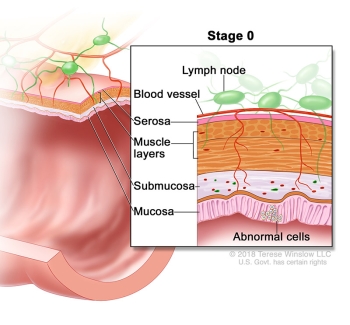
Stage I
The tumor has grown through the mucosa and has invaded the muscular layer of the colon or rectum. It has not spread into nearby tissue or lymph nodes (T1 or T2, N0, M0).
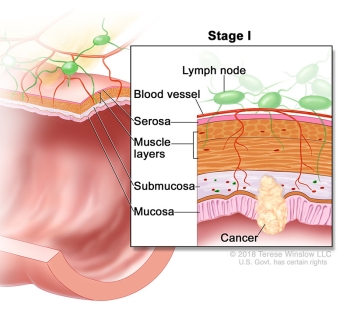
Stage IIA
The cancer has grown through the wall of the colon or rectum but has not spread to nearby tissue or to the nearby lymph nodes (T3, N0, M0).
Stage IIB
The cancer has grown through the layers of the muscle to the lining of the abdomen, called the visceral peritoneum. It has not spread to the nearby lymph nodes or elsewhere (T4a, N0, M0).
Stage IIC
The tumor has spread through the wall of the colon or rectum and has grown into nearby structures. It has not spread to the nearby lymph nodes or elsewhere (T4b, N0, M0).
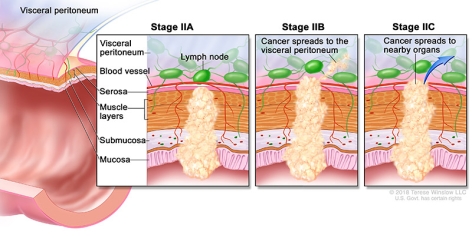
Stage IIIA
The cancer has grown through the inner lining or into the muscle layers of the intestine. It has spread to 1 to 3 lymph nodes or to a nodule of tumor cells in tissues around the colon or rectum that do not appear to be lymph nodes but has not spread to other parts of the body (T1 or T2, N1 or N1c, M0; or T1, N2a, M0).
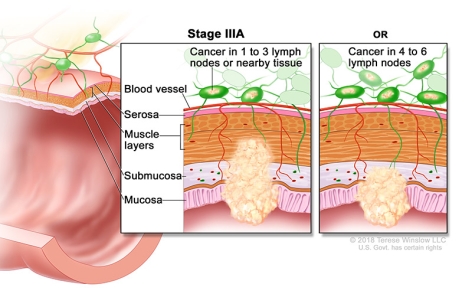
Stage IIIB
The cancer has grown through the bowel wall or to surrounding organs and into 1 to 3 lymph nodes or to a nodule of tumor in tissues around the colon or rectum that do not appear to be lymph nodes. It has not spread to other parts of the body (T3 or T4a, N1 or N1c, M0; T2 or T3, N2a, M0; or T1 or T2, N2b, M0).
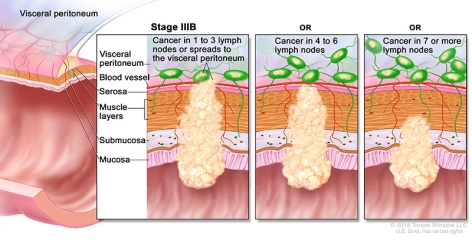
Stage IIIC
The cancer of the colon, regardless of how deep it has grown, has spread to 4 or more lymph nodes but not to other distant parts of the body (T4a, N2a, M0; T3 or T4a, N2b, M0; or T4b, N1 or N2, M0).
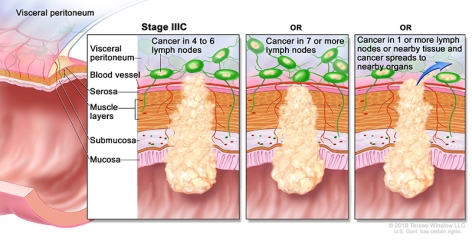
Stage IVA
The cancer has spread to a single distant part of the body, such as the liver or lungs (any T, any N, M1a).
Stage IVB
The cancer has spread to more than 1 part of the body (any T, any N, M1b).
Stage IVC
The cancer has spread to the peritoneum. It may also have spread to other sites or organs (any T, any N, M1c).
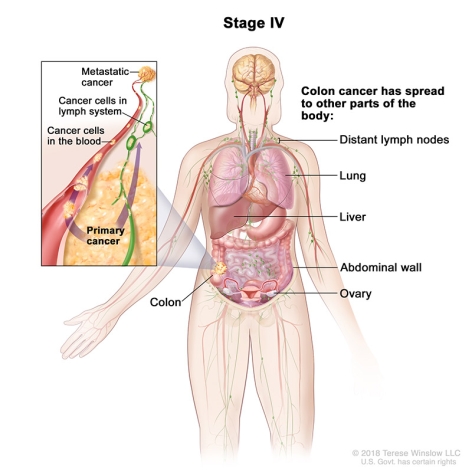
Recurrent
Recurrent cancer is cancer that has been treated and has returned after a period of time when the cancer could not be detected. The disease may return in the colon or rectum or in another part of the body after colorectal cancer treatment.
Based on the stage of cancer and the patient’s overall health condition, a treatment plan will be recommended to each patient.

 Learn More
Learn More